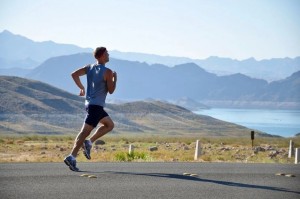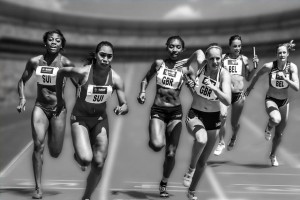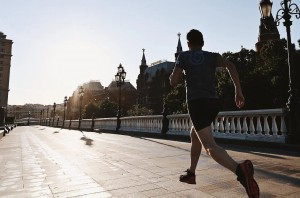The running pattern is quite subjective
At least this is people’s traditional understanding of running patterns. To achieve perfect movements, swimmers have to practice the stroke, emerging tennis players have to spend hours practicing the correct footwork and swing movements, golfers have to constantly strive to adjust their methods, but runners usually only need to run. It is generally believed that running is a basic sport and does not require any instruction manuals.
But runners tend to run as naturally as breathing, without thinking, planning or practicing a coordinated gait too much. According to the common view, every runner naturally optimizes their running pattern during training, and the gait pattern formed in this process involves the functions of the runner’s own unique anatomical and neuromuscular characteristics. The method of imitating other runners or, more precisely, learning running patterns from coaches or textbooks is regarded as a dangerous behavior because it may not conform to one’s own functionality and even cause physical injuries.
This widely popular notion is actually illogical and has been overturned by facts. After all, running consists of repetitive movements, and all runners are repeating one movement. When the running speed increases, almost all runners will increase the flexion of the knee joint during the leg swinging and sweeping phases of the gait (swinging one leg forward off the ground and then backward before the next contact with the ground). Many runners reduce the flexion of their knee joints during leg swings when running downhill and increase it when going uphill rapidly. During the leg swing period, all runners will activate the levator rope muscles to control the forward movement of their legs. When a runner moves forward, the trajectory each foot leaves on the ground and in the air is in the shape of a “green bean”, and this trajectory is called the “motion curve” or the path of the foot and leg within a stride.
The basic mechanisms and neuromuscular patterns of running are not special, so it is highly questionable whether each runner can form their own optimal gait pattern. Apart from walking, no other human activity can achieve the best improvement without guidance and learning like running. Skeptics might ask what constitutes “the best” when runners develop their own running styles. First of all, it definitely cannot prevent the physical harm caused by running to runners, because 90% of runners get injured every year. Secondly, its exercise efficiency is not high either, because research reveals that specific types of training can change the running pattern and thereby improve efficiency.
Run with square tyres
The unfortunate consequence of the notion that all runners will naturally form their own unique optimal running patterns is that most runners do not spend enough time improving their patterns. The Bijing running mode is already the best. Why try to change it? Serious runners will spend a lot of time formulating challenging training plans to improve key variables that affect athletic performance levels, such as maximum oxygen consumption, lactate circle value, fatigue resistance and maximum running speed. However, they overlooked their own gait patterns and failed to master the strategies for improving gait quality. This usually leads runners to develop powerful “machines” – strong hearts that can pump a large amount of oxygen-rich blood to the leg muscles, which also have a high oxidation capacity. However, runners rarely achieve the best performance level through these “machines” because their legs do not form the optimal interaction with the ground (that is to say, the way of leg movement is not optimal). This is just like equipping a car with a Rolls-Royce engine inside but installing square tires made of stone on the outside.
A beautiful runner
Another traditional view holds that the appearance of a runner when running is the key to the running pattern. Generally, expressions of tension and pain, as well as the appearance of head shaking, are not encouraged. Excessive twisting of the upper body and excessive arm movements are usually not permitted, as if upper body movements were the key decisive factor for the correct running pattern. Common sense suggests that running should be a smooth and rhythmic exercise, and the correct pattern should enable runners to avoid winnowing and pushing.
However, shouldn’t the correct pattern be more important than smooth movements and body control? Shouldn’t the work of the feet, ankles and legs be accurately described through precise and scientific data such as joint and leg angles, limb postures and movements, and ankle joint angles when the feet first contact the ground (rather than vague instructions such as raising the knees, relaxing the knees, and keeping the ankles elastic)? After all, the driving force for moving forward comes from the legs rather than the upper body – the correct pattern should be able to produce better, faster, more efficient and less injury-prone movements. The important thing is to clearly define what the lower body should do (through exact data, rather than just using words), which is what this article is going to tell you.
Running patterns and running efficiency. Traditional pattern research mainly focuses on the efficiency of movements. Animal studies show that animals usually move in the most energy-efficient way. At first glance, studies on the running efficiency and patterns of human runners seem to confirm the view that running patterns are “personalized” (which holds that everyone forms a running pattern that suits them), because some studies do suggest that runners naturally form their optimal stride length, and stride length is a key factor in running patterns. An investigation found that, under normal circumstances, the natural stride of runners is only 1 meter, which is far from the most efficient running strideTo understand this type of research, it must be noted that running efficiency is defined based on the amount of oxygen consumed during running. If two runners move at the same speed, the one with lower oxygen consumption (measured by oxygen consumption per kilogram of body weight per minute) is more efficient. High efficiency is a predictor of performance level. At any speed, compared with low-efficiency runners with similar aerobic capacity, high-efficiency runners have a lower ratio of oxygen consumption to their maximum oxygen consumption during running and exert less effort. Since leg movements consume oxygen during running, a reasonable assumption is that improving efficiency is a fundamental goal of improving the mode. In other words, the transformation of the pattern should be a conscious reformation of the optimal leg movements to enhance efficiency.
In another study, when runners relatively slightly increased or decreased their stride length, the efficiency of running did indeed decrease. Therefore, is it possible that the optimal stride of a runner is a natural outcome of training without the need for targeted stride guidance? Moreover, if they can optimize their stride length, wouldn’t other aspects of gait also be able to optimize themselves? Since naturally formed patterns are suitable for the body, doesn’t this mean that runners should avoid adjusting their original patterns?
Simply speaking, the answer is negative. These studies on stride length and efficiency have deep methodological flaws. When a runner changes his running pattern, after several weeks, his running efficiency will gradually improve. The short-term situation after the change of running mode does not demonstrate the ultimate impact of this mode change on the efficiency of runners. These studies lasted for too short a time and actually did not support the view that runners naturally optimized their stride length. As a further refutation to the theory that running “has itself”, studies have shown that significant changes in running patterns can significantly improve running efficiency.
Post time: Apr-28-2025




